READY TO GET STARTED?
REQUEST A FREE ESTIMATE
Fill out the form below or call (888) 466-7849 for a free, no-obligation estimate.

If you’ve discovered a buzzing colony of honeybees on your property, you might be wondering what to do. Don’t worry—there’s a way to handle this situation that protects both your home and these important little pollinators! Honeybee relocation is a great solution, and local beekeepers are key to making it happen.
Honeybees are vital for pollinating plants, which helps flowers bloom and fruits and vegetables grow. But sometimes, they end up in places that aren’t ideal for homeowners. This is where beekeepers step in to relocate the colony, giving the bees a better location while ensuring your property is free of concerns.
Here’s why local beekeepers play such an important role in this process and how it benefits homeowners like you.
Honeybees play a huge role in our environment. They pollinate about one-third of the crops we eat, including fruits, vegetables, nuts, and more. Without them, plants wouldn’t grow as well or produce as much food.
However, as urban areas expand and natural spaces shrink, honeybees sometimes end up building their hives in places like walls, attics, or trees near homes. Relocation protects their colonies and ensures they can continue their important work elsewhere, away from high-traffic areas or living spaces.
Beekeepers are experts in handling honeybee colonies. Their knowledge and care make relocation possible while keeping the bees healthy and productive. Here’s how they help:
When honeybee colonies need to be relocated, local beekeepers and pest control professionals often team up. Here’s what the process looks like:
Choosing honeybee relocation not only solves the immediate problem of a hive on your property but also helps the environment in several ways. Here’s how you benefit:
Honeybees are facing growing challenges like habitat loss and pesticide use . The work of local beekeepers in relocating hives is crucial for supporting bee populations. Without honeybees, we risk losing countless plants that depend on them, from garden flowers to crops that feed our families.
By choosing relocation over extermination, homeowners can make a big difference. It’s a simple decision that protects the bees, your property, and the environment.
Next time a hive appears near your home, remember that local beekeepers are here to help. They’re not just moving bees—they’re protecting pollination, promoting agriculture, and contributing to a thriving planet. Together, we can all do our part to support these incredible pollinators and keep our communities blooming. If you find a hive on your property, reach out to honeybee experts to responsively relocate the bees and protect your space, all while supporting a healthier environment.

Bees are some of Georgia’s most essential pollinators, yet they face increasing threats from habitat loss, pesticides, and climate change. For homeowners looking to cultivate beautiful and eco-friendly gardens, planting bee-friendly plants can provide a non-toxic environment for these critical pollinators, all while enhancing the vibrancy of backyard spaces.
This blog explores the best bee-friendly plants for Georgia gardens, including native flowers, beneficial herbs, and flowering trees and shrubs. Whether you’re a seasoned gardener or just starting your green-thumb journey, these plant recommendations will help you create an inviting habitat that supports pollinator health.
Before we dig into plant recommendations, it’s important to highlight why bee-friendly gardens matter:
By including the right plants, you enable bees to thrive while also enjoying a more stunning, productive backyard. Now, let’s explore the best options for your Georgia garden.
Georgia’s climate is rich in biodiversity, making it an ideal environment for native flowers. These plants naturally thrive in the region’s soil and climate while offering crucial resources to native bees.
Purple Coneflower is a favorite among gardeners and pollinators alike. With its daisy-like petals and vibrant purple hue, this perennial attracts numerous bee species, including bumblebees and carpenter bees. It’s hardy, drought-resistant, and blooms throughout summer, providing lasting nourishment.
Known for its golden-yellow petals and dark centers, Black-Eyed Susan is a pollinator magnet. These vibrant flowers not only attract bees but also support butterflies and songbirds.
Coreopsis, often called “tickseed,” is a cheerful perennial that thrives in Georgia gardens. Bees love their bright yellow flowers, which bloom prolifically when exposed to full sunlight.
Lavender serves a dual purpose in gardens, offering a soothing fragrance to humans and a rich source of nectar to bees. Its tall, purple flowering spikes are irresistible to a variety of pollinators.
While most people grow basil for its culinary uses, it’s also a bee-loving herb if allowed to flower. Its small clusters of white or purple blooms provide nutrients for pollinators throughout the season.
Rosemary’s evergreen foliage and tiny blue blooms make it a favorite in Georgia gardens—both for pollinators and gardeners. Its flowers can appear even in winter, providing much-needed nectar during colder months.
Flowering trees and shrubs create a stunning visual centerpiece in your yard while offering significant benefits for pollinators. These larger plants serve as vital food sources and shelter for bees in your region.
One of Georgia’s most beloved native trees, the Redbud graces gardens with its vibrant pink blossoms in early spring. Its flowers are among the first food sources for bees after winter hibernation.
The Tulip Poplar, often referred to as the “bee tree,” features distinct yellow-green flowers that are highly attractive to bees. This towering tree is a staple for pollinators looking for abundant nectar.
Nothing captures the beauty of Southern gardens quite like the Southern Magnolia. Its large, fragrant white blossoms are not only a visual feast but also a rich nectar source for native pollinators.
After selecting the right plants, the following tips will ensure your Georgia garden remains a bustling bee haven:
By implementing these practices, you’ll create not just a beautiful garden, but a thriving ecosystem that supports pollinators in the Georgia region.
Bee-friendly gardening is more than just a trend—it’s an investment in the environment and the future of pollinators. By planting native flowers, herbs, and flowering trees and shrubs, you’re building a sanctuary for bees while enjoying vibrant blooms, fragrant herbs, and a healthier landscape.
If a beehive has ended up in an unwanted place on your property, our honeybee experts are here to help! Contact our team for eco-friendly pest control solutions to protect both your home and these essential pollinators.
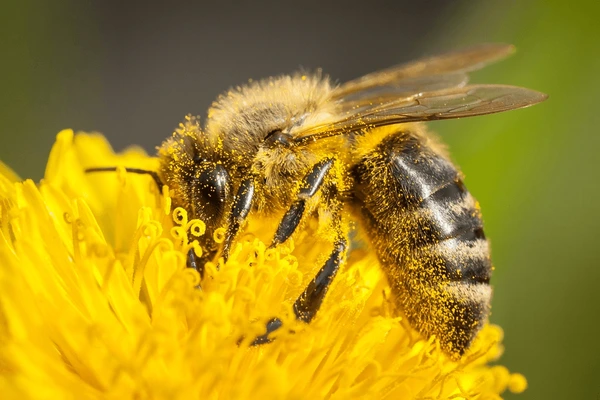
Bees are some of the hardest working creatures out there. They pollinate flowers, fruits, and vegetables, making our gardens grow and keeping our food supply strong. If you’re living in Metro Atlanta and want to welcome more bees to your yard, it’s easier than you might think! By making a few small changes, you can create a bee-friendly yard that helps these vital pollinators thrive. Here’s how.
Bee populations have faced many challenges over the years—things like habitat loss and climate change. Without bees, a lot of the plants we rely on for food and beauty wouldn’t thrive. Creating a bee-friendly yard is one-way homeowners can make a big difference. Even small adjustments on your property can provide bees with the resources they need to keep buzzing and pollinating.
Not sure where to start? Here are some simple steps to transform your yard into a haven for pollinators.
Native plants are like a bee’s favorite restaurant—they provide the perfect food and habitat. Bees especially love plants that produce nectar and pollen, so consider adding a variety of flowers, shrubs, and trees that bloom at different times of the year to feed them throughout the seasons.
Some great options for Metro Atlanta include:
Having a mix of colors, shapes, and sizes will also attract a wider variety of bees and other pollinators.
Bees are highly sensitive to pesticides, herbicides, and other chemicals. Instead of using traditional weed killers or harsh sprays, try natural alternatives. For example:
Going chemical-free is not only better for bees but also for your entire backyard ecosystem. Look for green pest control options!
Bees get thirsty too! Add a simple water source to your yard, but make sure it’s bee-friendly. A shallow dish of water with pebbles or floating wood pieces will help bees drink without risking them getting stuck. Change the water regularly to keep it fresh.
While we love a well-manicured yard, bees appreciate a bit of wildness. Allow part of your garden to grow naturally, leaving wildflowers or clovers to sprout. You can even create a small “bee corner” filled with pollinator-friendly blooms and plants that don’t need much trimming.
Not all bees live in hives like honeybees. Many, like bumblebees and solitary bees, make their homes in the ground or inside hollow stems. Consider leaving some bare soil or building a small bee “hotel” from wood, bamboo, or other natural materials. It’s a fun project and a great way to attract nesting bees.
The best part of creating a bee-friendly yard is that the effort pays off in more ways than one. Bees will love your yard, and you’ll benefit too! Here’s how:
You don’t need to overhaul your entire yard to make it bee-friendly. Start small by planting a few native flowers or setting out a water dish. Little changes can make a big impact over time.
If you’d like more tips or professional help with creating a bee-friendly space, or if you need assistance managing an unexpected hive, reach out to your local bee relocation company. They’re there to support you and the bees, making your yard both beautiful and welcoming for pollinators!

Bees are essential to our ecosystem. They pollinate flowers, fruits, and vegetables, making them integral for Tennessee’s lush gardens and thriving agriculture. However, typical pest control practices often inadvertently harm these invaluable insects. As a Tennessee homeowner, balancing pest control with environmental responsibility is a challenge—but not an impossible one. This guide focuses on bee-friendly pest control practices that help protect these vital pollinators while keeping your home and garden pest-free.
Bees are not just important for the environment—they contribute directly to the economy of states like Tennessee. From pollinating crops like apples, watermelon, and pumpkins to supporting wildflower blooms that benefit local wildlife, bees play a huge role. Unfortunately, widespread pesticide use has been a key contributor to the decline of bee populations. This decline could have dire consequences for agriculture and biodiversity.
But with a few mindful changes to your pest control approach, you can support pollinator health while maintaining your home’s comfort and well-being. Read below to find out how!
When using pesticides, the timing of your application is one of the most critical factors for bee protection. Bees are most active during the daytime—typically from mid-morning to late afternoon. Applying pesticides during these peak hours increases the likelihood of exposing them to harmful chemicals. To minimize the risk, consider scheduling treatments in the early morning or late evening when bees are less active.
Instead, opt to spray pesticides:
By targeting these times, you reduce the chances of directly affecting bees while ensuring pests are still managed effectively. You can also ask your local pest control company if they can accommodate bee-friendly application times to further protect these important pollinators.
Not all pesticides are created equal. Some are formulated to minimize harm to beneficial insects like bees. When choosing a professional pest control company, look for those explicitly labeled as “bee-protected or “non-toxic to pollinators.”
Here’s what to avoid and what to consider:
These products allow you to take care of garden pests without risking the health of your local bee population. If in doubt, consult a pest control professional who prioritizes environmentally-friendly solutions.
Blanket-spraying your entire yard is not only unnecessary but also harmful to the environment. This approach increases pesticide exposure for non-targeted species, including bees. Instead, focus on spot-treating problem areas where pests are concentrated.
How to spot-treat effectively:
Spot-treating is a more targeted strategy that minimizes collateral damage to bees and other beneficial insects.
Bees rely on flowering plants for food, so when applying pest control measures, it’s crucial to leave a portion of your yard bee-friendly. Reserving areas of blossoming plants untouched by pesticides creates foraging zones for pollinators.
To encourage a pollinator environment:
By creating these havens, you ensure that bees can continue to thrive, even while managing pests elsewhere in your yard.
Companion planting involves pairing specific plants that naturally repel pests with your garden crops. For instance:
This natural method not only reduces your need for chemical pesticides but also supports pollinator activity.
While dandelions and clovers may be considered weeds, they’re important food sources for bees. Limiting mowing in areas where these plants grow allows pollinators to access vital nutrients, particularly in early spring.
For a sustainable pest control approach, partner with an eco-friendly company that prioritizes honeybee protection. Many services in Tennessee offer solutions that target pests while keeping pollinators unharmed. Homeowners can help by adjusting pesticide timing, choosing non-toxic treatments, and creating foraging zones. If a beehive ends up in an unwanted spot, contact our honeybee experts to responsibly rehome it.
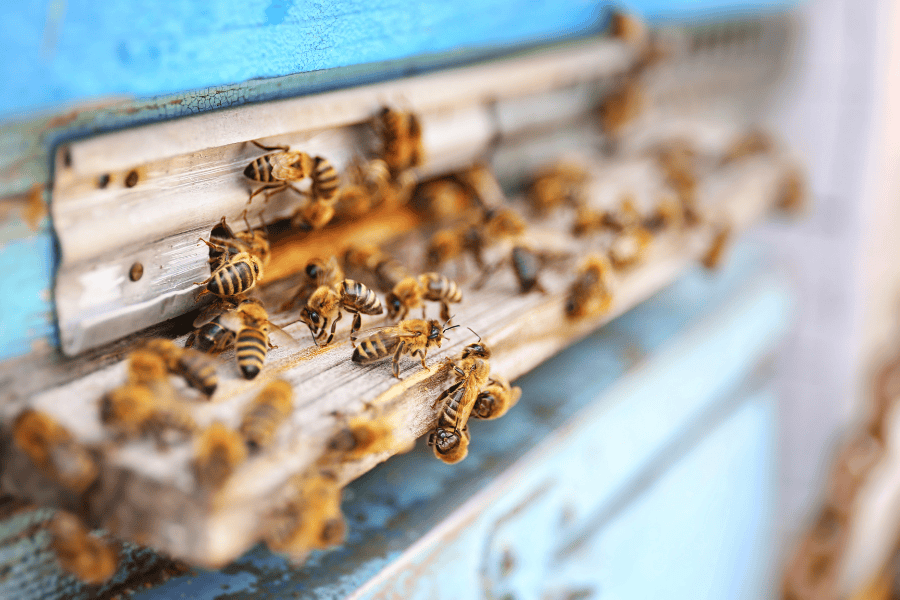
Bees play a remarkable role in maintaining our ecosystem. Their tireless work as pollinators supports the growth of plants that provide food, oxygen, and habitat for countless species, including us. However, when bees decide to make their home just a little too close to yours, it can pose challenges for homeowners. If you’ve noticed increased bee activity around your house, don’t panic! This guide will help you recognize the signs of a potential bee infestation and explain how professional help can manage the situation while staying out of harm’s way.
Before you assume you have a bee infestation, it’s important to identify the signs. Here are some telltale indicators that bees may have established a colony on your property:
Seeing a few bees in your yard is perfectly normal, especially in garden-friendly states like Georgia. But if you notice a consistent stream of bees flying to and from a specific location, it could be evidence of a nearby colony.
Bees commonly build their colonies within the walls or ceilings of homes. If you hear a faint but steady humming sound, especially in quiet rooms, it could be the sound of an active colony.
If bees have built a colony inside your walls, over time, melted honey or wax may create sticky or dark stains on surfaces. Inspect areas with staining or discoloration to check for other signs of bee activity.
Check attics, vents, chimneys, or exterior cracks in the foundation. Bees are resourceful when it comes to nesting, and these areas are common colony building spots.
A bee swarm can understandably seem alarming, but swarms are often temporary . Swarming typically happens when bees are searching for a new nesting site. If they’re congregating nearby, they might be looking to settle on your property.
We understand you might be tempted to address the problem yourself. However, when it comes to bees, DIY efforts can sometimes make matters worse. Here’s why leaving it to a professional is essential:
If you’ve identified signs of a bee infestation, partnering with a professional bee relocation service is the next best step. Specialists in handling bee situations offer tailored solutions that balance your needs as a homeowner with the wellbeing of the bee population. Here’s how experts can assist:
As a homeowner, it’s normal to feel concerned when bees settle a little too close for comfort. But with expert guidance and humane solutions, managing a bee infestation can be as stress-free as possible. Protect your home and support local pollinators by reaching out to your local bee removal experts today!
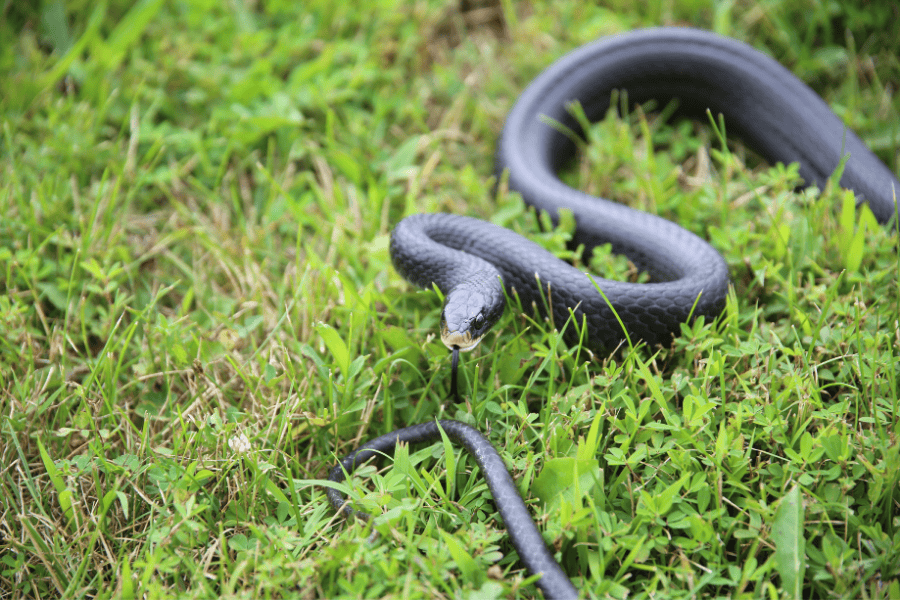
Georgia is home to a wide variety of snake species, both venomous and non-venomous. While most snakes play a vital role in the ecosystem by controlling rodent populations, their presence in and around homes can be unsettling. Understanding snake behavior, knowing what to do if you encounter one, and exploring snake pest control options can help you manage and prevent unwanted snake encounters.
Georgia has over 40 snake species, with only a few being venomous. Knowing the difference can help you determine whether a snake poses a danger.
Encountering a snake can be alarming, but staying calm is crucial. Here’s what you should do:
Many people wonder, “Can pest control get rid of snakes?” While traditional pest control focuses on insects and rodents, some wildlife control companies specialize in snake removal. These services include:
To prevent snakes from entering your property, consider the following snake control strategies:
Snakes are drawn to areas with ample food. Reducing rodents, insects, and bird eggs in your yard can deter them.
Snakes can enter homes through tiny gaps. Seal cracks, holes, and vents with mesh or caulk to prevent entry.
There are natural and commercial snake repellents available, including:
If you frequently see snakes on your property or inside your home, it’s time to call a wildlife control company. Professional snake removal services ensure:
Snakes are an essential part of Georgia’s ecosystem, but they can be a nuisance when they invade homes and yards. By identifying common snake species, knowing what to do if you encounter one, and implementing snake pest control strategies, you can minimize encounters. If you have persistent snake problems, a professional wildlife control company can provide safe and effective snake removal solutions.
For expert assistance in handling snakes on your property, contact a trusted pest control company specializing in snake control and wildlife removal.

As temperatures drop in Georgia, wild animals, particularly squirrels, begin seeking shelter from the cold. While their playful antics can be enjoyable to watch in your yard, squirrels can quickly turn into a wildlife problem when they invade your home. Understanding why squirrels become problematic in the winter, how they gain access to your home, and wildlife control methods you can use to eliminate them can help you stay one step ahead of these resourceful rodents.
Squirrels are among the most active wild animals during winter, despite the cold. Unlike hibernating species, they remain awake and spend much of their time foraging for food and securing warm places to nest. Unfortunately, this often leads them to target homes as their winter havens.
When squirrels enter your home, they can cause significant damage, including:
Squirrels can reproduce quickly, and what begins as a small wildlife problem can escalate into a major nuisance wildlife control challenge if not addressed promptly.
Squirrels are agile climbers and excellent chewers, making it easy for them to find entry points into your home. Common ways they gain access include:
Once inside, they quickly make themselves at home, chewing and nesting in attics, crawlspaces, and even walls.
Stopping a squirrel infestation before it starts is key to avoiding costly damage. Here are some effective prevention tips:
While DIY methods may seem appealing, handling wild animals can be dangerous and ineffective if not done properly. A professional wildlife control company has the tools, experience, and knowledge to:
If you’re searching for “wildlife control near me” in Georgia, look no further than a trusted local wildlife control service. Protect your home and family from the risks of squirrels and other wild animals this winter by enlisting the help of experienced professionals.
Don’t let squirrels make your home their winter retreat. Contact a professional wildlife control company today to schedule an inspection and ensure your home stays safe and secure all season long.
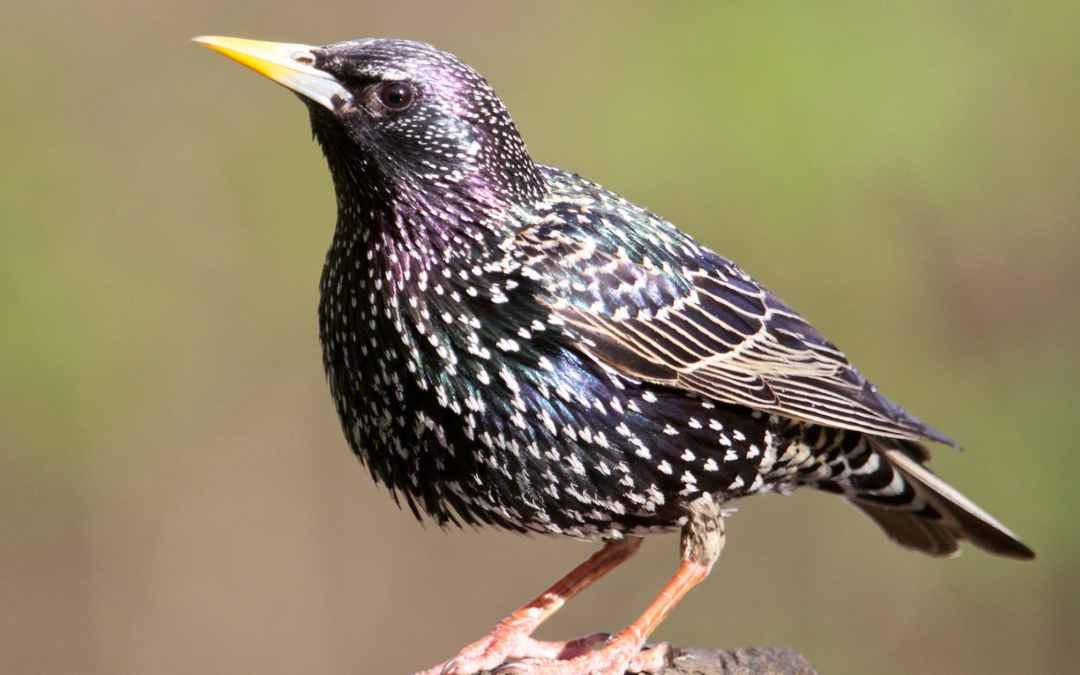
When it comes to pest control, most homeowners think of rodents, insects, or larger wildlife. However, one species of bird, the starling, can cause significant problems for property owners in Georgia. With their large flocks, destructive habits, and invasive nature, starlings have become a nuisance in both urban and rural areas. This blog will explore what starlings are, how to identify them, why they are considered a nuisance, and effective and legal ways to manage their presence around your home.
Starlings, specifically the European starling (Sturnus vulgaris), are small to medium-sized birds that were introduced to North America in the late 19th century. A group of bird enthusiasts, inspired by William Shakespeare’s references to the starling, released 100 of these birds in Central Park, New York, in 1890. What followed was an ecological domino effect that resulted in the species spreading across the entire continent. Today, starlings are classified as an invasive species in the U.S., meaning they compete with native birds and wildlife for resources, often to the detriment of local ecosystems.
Starlings are distinctive birds, making them relatively easy to identify. They have short tails, pointed yellow beaks, and glossy black feathers that shimmer with hints of purple and green in the sunlight. During the winter months, their feathers are speckled with white spots, adding to their recognizable appearance.
They are often seen in large flocks, especially during their breeding season in the spring and early summer. They are incredibly vocal, known for their variety of chirps, whistles, and even mimicking other birds and sounds. If you notice large groups of noisy black birds swarming your yard, you’re likely dealing with these nuisance birds.
Starlings are more than just noisy birds—they can cause significant issues for homeowners and the environment. Here’s why:
Starlings are omnivorous, meaning they eat both plant and animal matter. Their diet includes insects, earthworms, fruits, seeds, and grains. In urban areas, starlings often scavenge for leftover human food, adding to their reputation as a nuisance in populated areas. During the breeding season, their diet shifts to more protein-rich foods like insects, which they feed to their chicks. Their adaptability in diet allows them to thrive in various habitats, from urban areas to farmlands, making them difficult to control.
Given their ability to form large flocks and cause property damage, controlling starling populations can be challenging. Here are some effective and legal methods to reduce starling activity around your home:
The most effective way to deal with starlings is to prevent them from entering your property in the first place. Sealing off vents, chimneys, and other potential nesting sites can stop starlings from setting up nests in your home. Installing bird netting around high-traffic areas such as attics and eaves can deter them from gaining access.
Starlings are known to avoid certain visual and auditory deterrents. Hanging reflective objects like aluminum foil strips or installing bird spikes on ledges can make your home less appealing. You can also use sound machines that play predator calls or distress signals to scare starlings away.
Starlings are opportunistic feeders. Removing easy access to food by securing garbage cans, picking up fallen fruits, and using bird feeders designed to exclude starlings can reduce their presence in your yard.
For more extensive infestations, contacting a wildlife control company that specializes in bird control may be necessary. These professionals can implement more advanced strategies such as trapping or relocating starlings. In some cases, they may even use chemical repellents that are safe for both the birds and your family.
It’s important to note that while starlings are invasive, they are still protected under some federal laws. The Migratory Bird Treaty Act (MBTA), passed in 1918, protects many bird species from being hunted or harmed without a proper permit. However, starlings, along with other invasive species like pigeons and house sparrows, are not afforded the same protections under this law. This means that homeowners and wildlife services can legally take action to reduce starling populations on their property, as long as it is done humanely and within local regulations.
During the breeding season, starlings are especially active as they search for food and nesting sites. This is the time when large flocks can form, and their presence can become overwhelming for homeowners. It’s crucial to take preventive measures before the breeding season begins in the spring. By sealing entry points and removing food sources early, you can prevent starlings from making your home their nesting site.
Starlings, with their adaptability and invasive nature, can pose significant challenges for Georgia homeowners. Their large flocks, property damage, and competition with native species make them a nuisance that requires proactive control methods. By identifying these birds early and implementing exclusion and deterrent strategies, you can reduce the likelihood of a starling infestation. If your starling problem persists, contacting a professional wildlife control company that specializes in bird control can ensure the issue is managed legally and effectively.
Whether you’re dealing with starling flocks or preventing them from nesting in your home, understanding these nuisance birds and taking swift action is key to protecting your property and local wildlife.
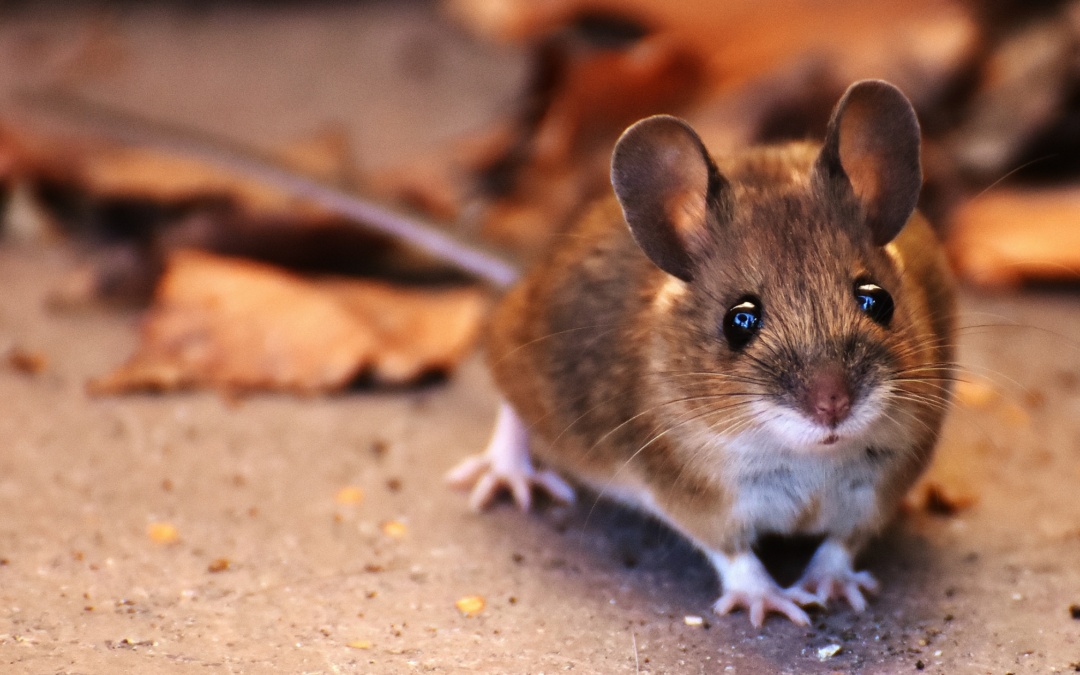
Rodents are a common issue for homeowners in Georgia, particularly during certain times of the year. Understanding when these pests are most active, the risks they pose, how they infest homes, and how to prevent them can help protect your home from unwanted intrusions. In this guide, we’ll dive into the types of rodents found in Georgia, the signs of a rodent infestation, and effective rodent control methods, ensuring you can safeguard your property all year round.
In Georgia, the most common rodents that homeowners may encounter include:
Each of these rodents can cause significant damage to homes and property while also posing health risks to humans.
Rodents are active throughout the year in Georgia, but their behavior varies depending on the season:
Because of Georgia’s relatively mild winters, rodents can stay active year-round. However, it’s the fall and winter months when infestations typically peak, as rodents prioritize indoor shelter for survival.
Rodents are not just a nuisance; they pose serious health risks and can cause costly property damage. Here are the primary concerns associated with rats and mice:
Rodents are highly adaptable creatures that can enter homes through small cracks, gaps, and holes in walls, foundations, and roofs. In fact, a mouse can squeeze through an opening as small as a dime, and rats need only a quarter-sized gap.
They are drawn to homes for three main reasons:
To protect your home, it’s crucial to identify the early signs of a rodent infestation. Here’s what to look out for:
If you notice any of these signs, it’s time to take immediate action to prevent a full-blown rodent infestation.
Preventing a rodent infestation requires a combination of proactive measures and regular pest control services. Here are some effective ways to keep rodents at bay:
While DIY rodent control methods can be helpful for prevention, a professional rodent exterminator is essential if you have an active infestation. Pest control experts have the tools and knowledge to identify the extent of the infestation and eliminate rodents safely and effectively.
In addition to removing rodents, a professional pest control company can help prevent future infestations through regular inspections and treatments. Many homeowners search for rodent control near me to find a reliable pest control company that offers tailored solutions for their needs.
Rodents in Georgia are a year-round concern, with peak activity occurring during the fall and winter months. By understanding the risks rodents pose, recognizing the signs of an infestation, and taking preventative measures, you can protect your home from these destructive pests. However, when a rodent problem becomes too large to handle on your own, it’s time to call in the professionals. Whether you’re dealing with rats and mice or other household pests, a trusted pest control company can provide the rodent control solutions you need to keep your home safe and pest-free.